Mammillaria matuda



Soft wooded
No secondary (woody) tissue being formed. The texture is fleshy and is soft, easy to cut.
Clumping
A plant that when multiplies forms a clump.This cylindrical cactus forms a solitary or clustered habit. It has conical tubercles and produces up to 20 white spines and the pinkish funnel-shaped flowers appear during the daylight in summer. It is commonly grown as a potted specimen plant.
Mammillaria matuda is naturally found in Mexico growing in stony well-drained soils in a open sunny position and is drought tolerant but frost tender.
Pincushion Cacti is a small cactus that is grown for its colourful flowers and is planted in cacti gardens or grown as a potted specimen for outdoors or as a houseplant. In cold climates it is grown in a hot house establishing from division in 2 to 3 years. It is easy to maintain and is a good beginner's plant for a sunny position. It has a low water requirement once established (Scale: 1-drop from 3), take care as the plant rots easily in wet soils.
Mammillaria (mam-mil-AR-ee-uh) matuda (mah-TEW-dah)
Cactaceae (kak-TAY-see-ee)
This is a family of succulent plants that have pronounced spines on their stems and may be scramblers, clumping shrubs or epiphytes.
Distribution
This family is found in the temperate regions of North and South America, in arid to semi-arid environments.
Diagnostic features
The leaves are not normally produced but instead the flattened stems contain areoles from which spines may or may not arise.
The flowers are borne on a floral tube with numerous perianth segments with the outer being green and the inner petiolate and brightly coloured. There are numerous stamens and the style is fleshy with three or more stigmas.
The ovary is fleshy and has contains many ovules surrounded by fleshy tissue that is edible when the fruit matures.
The drupe or berry fruit produces seeds that have little endosperm.
Note:
Many of the species are collected for ornamental use in containers and are admired for their exotic flowers.
Plants are classed as succulents as they resemble each other. They have fleshy leaves and stems, which can store water. There are three families, Cactaceae, Crassulaceae and Mesembryanthemaceae in which all the species are succulents.
Cactaceae is distinguished by the organ known as the areole, which are a small protuberance that is, arranged regular on the surface of the plant. It normally comprises of wool or hair with a number of spines.
Most of the succulents are indigenous to semi-arid environments with long dry periods followed by a short wet period. The plants swell absorbing water during these wet periods and reduce evaporation by having a waxy cover over the leaves or the leaves are crowded together in a rosette. Hairs and spines (modified leaves) also reduce the evaporation of water and most succulents form rounded shapes to reduce the surface area of the plant.
The size of the plant and flowering period is difficult to predict with succulents as the environmental factors such as weather and light variations control the flowering period. Soil type and available moisture influence the growth.
This plant tolerates between USDA zones 9a to 11a and grows to 0.3 m (10 in)
Fahrenheit 20º to 45ºF
These temperatures represent the lowest average.
Celsius -6.6º to 7.2ºC
Attention
All photographs and data are covered by copyright. Apart from any fair dealing for the purpose of private study, research, reference or review, as permitted under the Copyright Act, no part may be reproduced by any means with out written permission. All inquiries should be addressed to plantfile.com attention Peter Kirkland.

Funnelform
A flower where the petals form a funnel shape.
Solitary
When a flower that arises singly from within the axis of a leaf or terminally.| Jan | Feb | Mar | Apr | May | Jun |
| Jul | Aug | Sep | Oct | Nov | Dec |
The small pink funnelform flowers are arranged in a ring around the crown with the inner petals being more reddish. They appear from late spring to early summer.

Berry
A fleshy succulent indehiscent fruit, contains one or more seeds"Pincushion Cacti is a small cactus that is grown for its colourful flowers and is planted in cacti gardens or grown as a potted specimen for outdoors or as a houseplant. In cold climates it is grown in a hot house establishing from division in 2 to 3 years. It is easy to maintain and is a good beginner's plant for a sunny position.
Cactus and succulent cultural notes:
Outdoor cultivation
In warm regions with low humidity, cold and frosty night's cacti and succulents grow well outdoors. The more humid atmosphere will limit the number of successful species. All of these plants require a very well drained soil and ample sunlight to succeed. Once established these plants require minimal maintenance.
Indoor cultivation
Cacti and succulents grow well in glasshouses or near a sunny window with free air circulation and tolerate a marked difference in day and night temperatures.
Cacti have a rest period during mid winter when they can be stored in a cooler area with reduced watering, about once every two months or not at all. Protect the plants from freezing temperatures or extreme direct hot sunlight behind glass and all plants prefer a period outdoors during summer.
Watering
These plants normally have wet and dry periods. Watering should take place during the growing period of the plant. When new growth appears water well once a week and never water if the soil is already wet or place the pot in a saucer of water. Free drainage is essential for a healthy plant and succulents rot easily in moist humid conditions. When watering cactus avoid wetting the body in the sun as this will cause burning, which leads to scars or even fungal infections.
Fertilising
Cactus and succulents may vary in fertilising, requirements but generally they prefer a low nitrogen fertiliser that is rich in potassium and phosphorus and it should be apply monthly during the summer period. High nitrogen fertiliser tends to make succulent plants to soft and full of water.
Problems related to watering
Overwatering succulents results in leaves that wilt and discolour or stems that rot. Cactus also rots quickly if the soil remains moist.
Under watering results in a sudden loss of leaves or brown and dry spots appear on the leaves or body. Succulent leaves also fall if the water is too cold.
Pots
Both clay and plastic pots are suitable. The pot should fit the plant comfortably and not be too big as it may remain moist, rotting the plant. Quarter fill the pot with broken crocs or gravel to promote good drainage. After replanting don't water it for one week. Do not over water allow the soil to become dry before re-watering.
Re-pot only when the roots become congested in to a slightly larger pot. If the plants are very large and are difficult to re-pot replenish the surface soil and thoroughly water. Apply high potassium fertiliser monthly during summer, to encourage new growth.
Soils
For plants that are naturally found in Rocky sloping habitats a mixture of one parts sterilised loam, one parts shredded peat, two parts, sharp gritty sand or gravel and mixed with the composed leaf mould, that is granulated.
Desert cactus that are woolly or spiny use a potting mix of equal parts of sterilised loam, shredded sphagnum peat and gritty washed sand with the addition of one part limestone gravel all chips to assist in strong spine formation. (Never use powdered lime or chalk)
Sow fresh seed during spring on gritty loam bases compost and maintain a temperature of 19º to 27º C (66º to 81º F).
Divide mature offsets with there own roots attached during spring.
Propagation by seed (General)
Germination
In order for a seed to germinate it must fulfil three conditions.
1. The embryo must be alive (a viable seed).
2. The seed must have no dormancy-inducing physiological, physical or chemical barrier to germination; also the seed must be nondormant.
3. The seed must have the appropriate environmental requirements, water, temperature and oxygen.
The interaction between these requirements and dormancy is complex and may lead to different environmental requirements that avoid the dormancy of a seed.
Sowing seeds in containers
There are two general methods for germinating seeds.
Seeds in a flat or germinating bed, through which seedlings are pricked-out then, transplanted into another flat with wider spacing or directly to an individual pot.
2. Sowing seeds by placing them in to flats with the appropriate spacing or into individual pots.
This method is normally carried out with medium to large seeds such as woody plants and plants that are difficult to transplant.
Seedling production normally occurs in a greenhouse / glasshouse, cold frames and on hot beds.
Method of seed sowing
Fine seed is sown in pots or flats that are no deeper than 70 to 80 mm (3 1/8 in). using a sterilised well-drained media (soil). Fill the container to 20 mm (¾ in) from the top and sprinkle sieved peat to 3 mm (1/10 in) depth. Press the media down level and firm with a piece of timber and then thoroughly moisten.
Mix the fine seed with washed sand and then sow thinly on the surface. These may be lightly covered with sand.
Larger seeds may be covered with media or a hole is dibbled and the seed is placed in the media.
Watering methods
For watering you may either mist the containers from above or place the container in tepid water and allow the water to raise through the pot to the surface of the media, then drain away and do not fill to the top of the container.
Place a piece of glass over the pot and store in a protected warm environment (glasshouse).
Seeds germinate best in darkness so shade the containers if in direct sunlight.
After the seedlings have sprouted remove the glass and ease the seedlings into direct light.
When the seedlings are large enough prick them out and transplant into larger containers then place them in a shade house to harden off.
Many seeds have different methods of seed preparation for germination such as nicking or cutting the seed coat to allow water penetration, also placing seeds in hot water and allowing it to cool off.
This is particularly important as it is softening the seed coat.
Natural layering
Runners
These are stems that grow horizontal from the mother plant and form new plants from a node that form its own root system. When these daughter plants root up in the soil they are dug up and planted as a new plant.
Stolons
These are modified stems that grow horizontal to the ground or under the ground with nodes that can produce new plants as in a potato tuber. These can be cut away from the mother plant and form a new plant.
Offsets
This is a lateral shoot that forms from at the base of the mother plant. Often referred to in bulbs as bulblets or lateral branching in monocotyledons and appear as thickened stems and are removed close to the main stem. These natural methods are slow but microporpagation in aseptic culture has greatly enhanced production.
Suckers
The true meaning of a sucker is a shoot that comes from an adventitious bud on the roots, but generally it is referred to any shoots that arise from the crown of the plant. A sucker may be also seen as any shoot on a rootstock that is below the grafted section.
The method of removal is to dig out and cut it away from the mother plant with some roots attached to its base. It is then treated as a cutting, potted up and kept moist. This operation is normally carried out during the dormant period of the plant.
Crown division
The crown is the part of the plant at the surface of the soil where new shoots arise. With lateral shoots the crown of some plants requires division when they become crowded.
Herbaceous perennials and multi-branched woody shrubs may develop large crowns that need dividing.
It is a simple method of propagation that is used by amateurs and professionals for a small increase in plants.
Plants that flower during spring to summer are divided during autumn and if flowering in summer to autumn they are divided in spring. The crown is dug up then cut with a knife in to sections, which has a shoot and abundant roots then planted or potted up. The crown may also be divided in some species by using a shovel to cut and dig sections out.
PEST
NAME
Two-spotted Mite, Red Spider Mite
Tetranychus urticae
ORDER
Acarina
FAMILY
Tetranychidae
Description of the Pest
Also known as the red spider mite. Females are pale green or yellowish, depending on the host plant, and have two dark lateral markings; the mite becomes red in winter, retaining their dark markings. Nymphs are six-legged, with another pair of legs appearing as the mite matures. Males are smaller and narrower. Fully-grown adults are just visible to the naked eye. Two-spotted mites spread by crawling between nearby plants or movement of dead leaves.
Appearance and Distribution of the Pest
Found world-wide; an introduced pest in Australia. They congregate in protected places, such as under bark and at the base of trees, during winter. During spring, they become green in colour, and migrate back into the leaves. During heavy infestations, the leaves may be covered in visible webs, which they spin as they feed. Leaves may eventually wither and fall. Mites can spread via the movement of dead leaves, or in webs that have become attached to birds or large insects. They initially appear on the undersides of leaves.
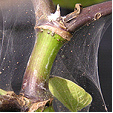
Spruce Spider Mite (Oligonychus ununguis) is a tiny greenish black adult which lays eggs on twigs where they overwinter. The pale green young spiders suck the sap turning the leaves yellow to brown. Heavy infestations form webbing and the pest is found on Abies and Juniperus species.
Banana spider mite (Tetranychus lambi) is a major widespread pest of bananas. It differs from two spotted mite by not producing copious amount of webbing. It is highly active during the dry spring to summer period and with the onset of the wet season mite numbers are reduced. The warm dry conditions that are created under plastic bunch covers is ideal for building up banana spider mite numbers.
Damage is normally confined to the underside of leaves appearing as rusty patches that coalesce along the leaf veins eventually turning the whole leaf brown-grey before it collapses. Fruit is damaged, close to the bunch stalk causing the area to become dull red purple-black, which in turn becomes dry then cracks.
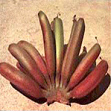 Damage fruit
Damage fruit
Control methods include careful water management during dry periods, and the reduction of dust from roadways. Regular desuckering and leaf trimming of plants will assist with a good coverage when spraying miticides.
Life Cycle
Mites have a gradual metamorphosis, with several nymphal stages. Each female lays up to 100 eggs that hatch in 7-14 days, with several generations appearing throughout the year. Females may become inactive during cold weather.
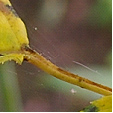 Webbing
Webbing 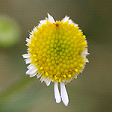
Period of Activity
The Two-spotted mite is most active in hot dry conditions. Under optimum conditions, the population can double every four days. It produces large quantities of webbing for over-wintering nests. Many plants are only susceptible to this insect when cultivated under glass.
Damage Caused
Adults and nymphs lacerated the undersides of the leaves with there rasping mouth parts, although infestations on both surfaces are not uncommon. Infestations cause leaf mottling leaf fall; premature leaf loss causes loss of vigour and reduces the quality and quantity of future crops. Repeated infestations, year after year, may weaken root growth and kill herbaceous plants.
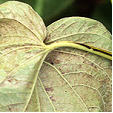
Susceptible Plants
A wide range of plants are attacked by the Red Spider Mite including annuals, fruit trees and vegetables, ornamental shrubs and trees.
Note
Many plant species are more susceptible to Red Spider Mite when they are cultivated under glass.
Other species of mite that are mentioned below have simular characteristics.
Calluna, Rose, Tropaeolum and Viola and species are infested with the Red Spider Mite (Tetranychus telarius) commonly in greenhouse situations.
Musa species are attacked by two spotted mite and banana spider mite damaging foliage and fruit.
Juglans species can be infested with up to four types of mites including red spider.
Cultural Control
Heavy rain or irrigation can reduce numbers; some plants may benefit from replanting in cooler locations. Generally, however, infested material should be completely removed and destroyed.
Preventative measures such as removing weeds or mulching around trees or shrubs or scrubbing the loose bark of susceptible trees during winter helps reduce numbers. During spring sticky bands can be wrapped around trunks close to the ground to trap the mites.
Biological Control
Natural predators include lacewings, ladybirds and thrips help keep the numbers down. Insecticide-resistant predatory mites (Typhlodromus occidenyalis) are also available commercially to control the Two-spotted Mite only on a large scale, as they require ample mites to survive.
Chemical Control
Spraying should be carried out as a last resort as many predators are killed during the operation and spraying can have the opposite effect by increasing numbers in the long term. Dimethoate will reduce numbers; however, Two-spotted mites are resistant to insecticides in some areas. Dusting with wettable sulphur may also prove effective.
Note
Always read the label for registration details and direction of use prior to application of any chemicals.
PEST
NAME
Scale Insect
Various Scale Species
ORDER
Hemiptera
Description of the Pest
Generally scales are soft bodied insects that have a hard (armoured) or soft covering to hide under. They have piercing and sucking mouth parts that are attached to the host, feed off sap and soft scales commonly producing sweet honeydew, which in turn attracts sooty mould and ants.
The adult female has a circular or oval covering depending on the species and is up to 8mm across. The first stage (crawlers) hatch and wander around the leaf surface until finding a suitable place to suck sap, normally in colonies and the smaller male is relatively inconspicuous.
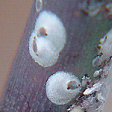 Hard Scale
Hard Scale 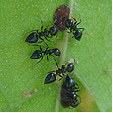 Soft Scale, attending Ants
Soft Scale, attending Ants
Cactus Scale (Diaspis echinocacti) has a circular greyish female and a narrow white male scale and is commonly found on house plants.
Chain Scales (Pulvinaria species) adult females are obvious with large group of eggs that are white or cottony-like, and the tiny young light green scales are flat and oval-shaped up to 2mm long. The legged nymphs are normally arranged from head to tail along the mid rib of the leaf, and may move to a new position to feed. They excrete honeydew and attract sooty mould and are found on Acacia and Acronychia species.
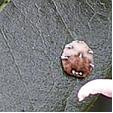 Chinese Wax Scale
Chinese Wax Scale
Chinese Wax Scale (Ceroplastes sinensis) is a domed wax scale that has dark spots around its margin and immature scales form waxy material around there margins.
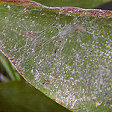 Fern Scale on Aspidistra elatior
Fern Scale on Aspidistra elatior
Fern Scale or Coconut Scale (Pinnaspis aspidistrae) appears as flecks up to 0.15mm long with a white covering over the male congregating on the underside of the fronds on the axils and among the sporangia causing them to turn yellow. Many species of fern are susceptible to infestation.
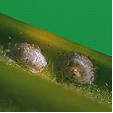
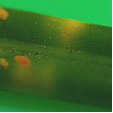 Flat Brown Scale
Flat Brown Scale
Flat Brown Scale (Eucalymnatus tessellates) are light brown up to 0.5mm long, flat and closely attached both sides of the leaf and causing yellowing of the foliage.
Juniper Scale (Diaspis carueli) is tiny and circular, white maturing to grey-black and as it feeds the needles turn yellow and die.
Oleander Scale (Aspidiotus hederae) is a pale yellow circular scale up to 3mm across and is found in dense colonies on the stem or leaves.
Tea-tree Scale (Eriococcus orariensis) are a creamy blue colour normally packed along the branches and are plump and rounded to 4mm across.

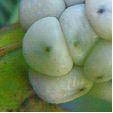 Wattle Tick Scale
Wattle Tick Scale
Tick or Wattle Scale (Cryptes baccatus) adult is domed, blue-slate colour with a leathery covering up to 10mm long. All stages of growth are found in groups of over forty, packed along the stems and normally tended by ants as they produce large amounts of honeydew. A serious pest of Acacia species found inland or coastal from temperate to sub tropical climates and commonly accompanied by Sooty Mould.
Toxic Scale (Hemiberlesia lataniae) is a tiny flat rounded scale up to 0.15mm long and is white to pale pink. It is normally found in colonies on the small branches and twigs of shrubs. It injects a toxic substance into the host as it sucks sap causing the death of the branch.
Wattle Scale (Pseudococcus albizziae) is soft, plump and secrets cotton-like threads. It is not a true scale insect and is simular to mealy bugs. It is reddish-brown up to 0.4mm long and secrets large amounts of honeydew as it sucks sap in colonies along the branches.
Life Cycle
These insects have a Hemimetabolous life cycle, ie. When the immature nymphs resemble the adults.
Appearance of the Pest
All parts of the plant above the soil may be attacked, but normally the stems and leaves and scale tends to favour well-lit positions.
Period of Activity
The nymphs and females are active for most of the year, in warm climates. Once they selected a position they attach and don't move. Normally the winged or wingless males are mobile and only soft scales produce honeydew.
Susceptible Plants
There is a wide range of susceptible plants including citrus, willows, holly, and many ornamentals, such as roses or Paeonia species. It also attacks indoor or glasshouse plants and Australian native plants such as wattles, hakeas, grevilleas and eucalyptus.
Acacia species are attacked by the Tick or Wattle Scale, which infest twigs and small branches and heavy infestations will kill the host plant.
Acer species are attacked by the Cotton Maple Scale (Pulvinaria innumerabilia) which prefers Acer saccharinum. Nymphs first attack the leaves and the brown adult scale is covered in a woolly mass up to 14mm across, normally found on the underside of the stems and twigs.
Acmena smithii, Melaleuca, Syzygium and Pittosporum species are attacked by the Chinese Wax Scale.
Aesculus species are attacked by several scale insects including the Walnut Scale (Aspidiotus juglans-regiae) which is saucer-shaped and attacks the main trunks.
Agave species are susceptible to several types of scale including (Aspidiotus nerii), (Aonidiella aurantii) and (Pinnaspis strachani), but generally do not require control.
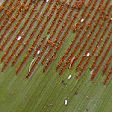 Asplenium australasicum
Asplenium australasicum
Asplenium australasicum is susceptible to Coconut Scale or Fern Scale (Pinnaspis aspidistrae). It is normally found on the under side of the fronds. Small infestations cause little damage.
Bougainvillea species may be attacked by the soft scale (Coccus hesperidum) outdoors or under glass.
Calluna and Vaccinium species are attacked by the Oyster Shell Scale (Lepidosaphes ulmi).
Camellia species may be attacked by the Florida Red Scale (Chrysomphalus aonidum), which is small, circular and black and is found firmly attached to the underside of the leaf along the veins. On inspection after removing the scale the insect has a pale yellow body. Camellias are also attacked by a large variety of scale insects including Tea Scale and Camellia Scale.
Carpinus species may be attacked by the scale (Phenacoccus acericola). It is found on the underside of the leaves forming a white cotton-like clump along the veins.
Casuarina and Allocasuarina species may be attacked by the Casuarina Scale (Frenchia casuarinae), a black hard scale that is upright to 4mm with a pinkish body. During attachment the surrounding tissue swells up and in time can, form galls. This weakens the wood and in severe infestations may kill the tree.
Cotoneaster species are attacked by up to four species of scale including the Oyster Shell Scale (Lepidosaphes ulmi).
Cupressus species are attacked by Bark Scale (Ehrhornia cupressi) is pink and covered in white wax. Heavy infestations cause the leaves to turn yellow or reddish.
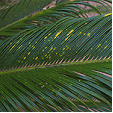 Flat Brown Scale on Cycas revoluta
Flat Brown Scale on Cycas revoluta
Cycads, palms and some species of Callistemon are attacked by the Flat Brown Scale.
Erica species are attacked by several species of scale including, Greedy, Oleander and Oystershell scale.
Jasminum species can be infested with up to twelve types of scale.
Juniperus x media and other conifer species are attacked by the Juniper Scale.
Leptospermum species are attacked by the Tea-tree Scale which produces ample honey dew that promotes sooty mould.
Palm and Fern species are susceptible to attack by the Coconut Scale or Fern Scale (Pinnaspis aspidistrae) which infests the underside of the leaves. They are also hosts for many other scale species such as red, cottony cushion and tea scale.
Pinus species are attacked by several species of scale including the Pine Tortoise Scale (Toumeyella numismaticum) and the Red Pine Scale (Matsucoccus resinosae).
Polygonum odoratum is attacked by a small brown scale.

Sorbus aucuparia is attacked by a five species of scale insect, including Black Cottony Maple, San Jose and Scurfy. Generally they suck on the sap of the new growth and leaves.
Strelitzia species are attacked by the Greedy Scale (Aspidiotus camelliae).
Damage Caused
Leaves become yellow and are shed prematurely and there may be twig or stem die-back. When the infestation occurs on fruit, the fruit is small and its skin becomes pitted and cracked. Small trees and saplings that are heavily infested may be seriously damaged or die. Sooty mould can cover fruit or leaves causing a secondary problem.
Cactus Scale can completely cover the host cactus sucking sap and causing it to die.
Cultural Control
Dead or damaged parts of the plant should be removed and destroyed including fallen fruit. Small infestations may be removed by hand or squashed on the stems. Healthy plants are less susceptible to attack, so maintain vigour of the plant and avoid using high-nitrogen fertiliser that produces excessive soft young growth.
When pruning susceptible plants paint the cuts with antifungal sealant paint as scale insects are attracted to the sweet smell of the sap. This will reduce the infection rate of the plant.
Biological Control
Natural predators such as parasitic wasps may reduce numbers of active nymphs; parasitic wasps are bred commercially in some areas for this purpose. It should be noted, however, that wasps would avoid dusty conditions.
Other predators that assist in control are assassin bugs, ladybirds, lacewings, hover flies and scale eating caterpillars. A variety of birds also attack scales.
The control of ants that transport aphid from one host to another also reduces infestation and can be carried out by applying at least three greased bandages 5mm apart around the stem or trunk of the plant.
Chemical Control
Spray the entire plant with dilute white oil solution; a follow-up spray may be required after four weeks, for heavy infestations. Spraying of chemicals will also kill of natural predators and in some cases the secondary scale infestation is more prolific especially when using copper based chemicals.
Some chemical controls, such as methidathion, are available - please seek advice from your local nursery as to the suitable product for your area.
Note
Always read the label for registration details and direction of use prior to application of any chemicals.
PEST
NAME
Mealybugs
Various Mealybug Species
ORDER
Hemiptera
FAMILY
Pseudococcidae
Description of the Pest
Adult females are 3-5mm long, flattened oval-shaped white insects, which secrete a white, mealy wax that forms a row of hair-like filaments of fairly uniform length around the edge of the body; the hind end bears one or two pairs of filaments that are longer than the others. They are mobile but slow-moving. The seldom-seen adult males are tiny winged insects with a pair of long waxy tail filaments. Early stage nymphs are tiny, pink and mobile; later stages resemble adult females.
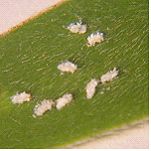
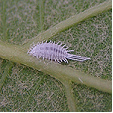
There are many types of mealybugs including;
· Longtailed Mealybugs (Pseudococcus longispinus) generally have tail filaments that are longer than there body. If squashed yellow body fluid is revealed and the eggs are laid under the body and normally hatch immediately.
· Citrus Mealybug (Planococcus citri). This insect has tail filaments that are less than 1/3 the length of its body. It produces yellow orange body fluid and lays eggs in a cottony mass.
· Citrophilous Mealybug ( Pseudococcus calceolariae). This insect has tail filaments that are about 1/3 the length of its body. It produces dark red body fluid and the eggs are laid in a cottony sac.
· Root Mealybug (Rhizeocus falcifer). This insect is not normally seen but produces a open white mass as it feeds on the outer or terminal roots, normally container plants, particularly cacti species. The eggs are laid in the waxy mass and adults may dispersed by ants.
· Hibiscus Mealybug (Maconellicoccus hirsutus)
· Tuber Mealybug (Pseudococcus affinis)
The Mealybugs (Pseudococcus adonidum) and (Planococcus citri) are a major pest of cacti species, sucking sap and turning the infected area yellow. These pests are also found on Strelitzia, Camellia and Yucca species.
Appearance and Distribution of the Pest
Mealy bugs are found worldwide. The above ground species are found in sheltered areas such as under a leaf or in leaf bases. They are also found where two fruits or leaves touch and are not readily noticeable.
The below ground species are only found when a plant is re-potted or the infected plant wilts and dies. Mealybugs are distributed several ways including slowly walking to a new host or transferred on clothing, contaminated plants or strong wind and on visiting insects. They are also farmed by ants which in a nursery situation infest pots by tunnelling and carrying mealybugs to the roots.
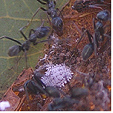 Attending Ants
Attending Ants
Life Cycle
These insects have a Hemimetabolous life cycle, ie. When the immature nymphs resemble the adults.
Up to 200 young are produced in 2-3 weeks; eggs may hatch as they are being laid. The life cycle includes eggs, nymphs (3 to 4 stages) to adult takes 6 weeks, in warmer months; several generations appear throughout the year.
Period of Activity
Active all year, particularly in spring and autumn. Warm, humid conditions are preferred and the insect overwinter outdoors as eggs. These may be found on surrounding weeds. In Citrus species many longtailed mealybugs overwinter as juveniles, maturing during spring. In a Glasshouse conditions mealybugs are active through the year.
Damage Caused
Adults and nymphs suck sap, congregating in sheltered parts of the plants; some species feed undetected on roots. Early infestations may go unnoticed until the plant begins to wilt. The insect also produces honeydew, which gives rise to sooty mould.
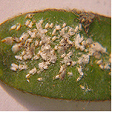
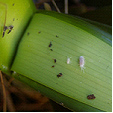 Clivia miniata
Clivia miniata
Susceptible Plants
Mealybugs are found on a wide variety of trees and shrubs. They are also destructive to many ornamentals; including indoor plants (especially African violets and ferns), and are a major greenhouse pest.
Cactus species
Many species of mealybug are common pest of cactus and succulents. The small, grey to light brown mealy bugs are difficult to see amongst the spines. Nesting females appear as the small balls of white fluff on cactus spines or around the base and under the rim of the pots. The female will produce eggs or living nymphs and the insect will produce honeydew that attracts ants. Ants should be discouraged as they farm mealy bugs, moving them from one place to another in a cactus collection.
Cactus is also attacked by the root mealybugs that infest the roots of plants and their damage allows fungal and bacterial infections to enter the plant tissue. They can be identified by white fluffy deposits in the soil or underneath a pot and appeared as tiny pinkish brown wood lice up to 3 mm long.
Catalpa species are susceptible to the mealybug (Pseudococcus comstocki) which is a wax covered mealybug that causes distorted growth of the branches and branchlets.
Fern species are commonly attacked by mealy bugs and can be recognised by small white, waxy secretions as it feeds in the crevices at vein junctions or on the exposed rhizome.
Hedera and Crassula species are susceptible to three species of mealybugs including Citrus Mealybug (Planococcus citri) and not normally requiring control.
Laburnum anagyroides is infested with the Grape Mealybug (Pseudococcus maritimus) infesting the branches and twigs.
Plumeria acutifolia becomes infested with mealybugs on the new growth but normally control is not required.
Psidium species are attacked by the Longtailed Mealybugs (Pseudococcus longispinus).
Sequoia species are attacked by three species of Mealybugs including (Planococcus citri).
Thymus species are attacked by the Root Mealybug (Rhizeocus falcifer).
Thuja species Cupressus macrocarpa and Araucaria heterophylla are can be infested with the mealybugs (Pseudococcus ryani).
Turf Grass may be infested with mealybugs causing severs damage and often go undetected and build up large colonies quickly. The turf forms brown dry patches and looks simular to Dollar Spot the infestation may also occur around core holes and can be discouraged by generous watering. Agrostis palustris (Bent) and Cynodon species (Couch) are commonly attacked.
Yucca species are attacked by the mealybug (Planococcus citri).
Cultural Control
Small plants may be sprayed with a soapy water solution or sponged down preferably during the evening. Heavily infected areas should be pruned and destroyed or the whole plant removed. Infested pot-plants should be discarded and thoroughly disinfect pots before recycling). Maintain vigour by watering to replace sap loss, this helps infected plants to recover.
As a preventative measure for root mealybugs grind up mothballs and add them to the potting mix to discourage infestations. Care should be taken as the chemicals in mothballs can damage plastic pots (use clay pots) and in some countries such as the UK. mothballs must be used as directed on the label.
Biological Control
Lacewing and ladybeetle larvae (Cryptolaemus montrouzeri) control small infestations. This predator insect requires temperatures of at least 21° C. (70°F) and in small infestations it is difficult to maintain a balance between predator and prey.
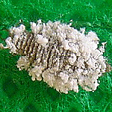
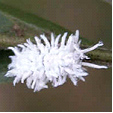
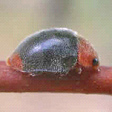
Ladybird beetle larvae eats Mealybugs Ladybird beetle up to 4 mm long
Chemical Control
Spray with white oil may have an effect on the population or spray Omethoate. Contact insecticides are usually ineffective because of the insect's protective waxy coating.
Note
Always read the label for registration details and direction of use prior to application of any chemicals.
DISEASE
NAME
Grey Mould
Botrytis cinerea, B. elliptica
Description
Grey Mold, Shoot Blight, Petal Blight is a fungus problem that generally forms water-soaked spots that rot and produces greyish sclerotia (fungal resting bodies) on the surface. They can be found throughout the year on dead tissue and on live material during under ideal climatic conditions. Damaged areas such as a tear in a leaf or an opening made by an insect are more likely to be infected.
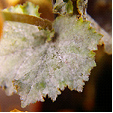 Grey Mold on Begonia species
Grey Mold on Begonia species
Image by B. Sonsie
Symptoms
The fungus attacks stems, leaves, flowers and fruit. In roses the fungus is primarily attacks the flowers producing pink rings on the petals and buds that become brown and rotten. This may extend down the peduncle to the stems causing dieback.
In other plants oval yellowish to brown spots appear, then the centre turns greyish and dries out and in humid weather the spots spread, joining up and infecting the entire leaf. This infection may also occur on the stems, and flowers may form abnormally or brown off and die.
When lettuce is infected it starts at the base causing a soft brown rot that may extend up the stem killing the plant, and pears flowers become infected then spreading to the fruit. This develops a sunken brown area that is soft and eventually is covered in grey powdery spores.
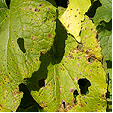
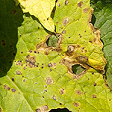 Botrytis Blight on Senecio cruentus
Botrytis Blight on Senecio cruentus
Botrytis Blight (Botrytis tulipae) infects leaves, flowers and stems with flecks of brown spots that merge to form light grey rotted areas that have brownish margin that may destroy stems. Affected areas are covered in a grey mould during humid conditions. The spores overwinter in dark brown sclerotia, which are found on the outer scales of the bulb or at the base of the stem in Tulipa species.
Grey Bulb Rot (Rhizoctonia tuliparum), which infects the bulbs of Tulipa species, attacking the base of the leaves and rotting the bulb. When bulbs emerge during spring in infected soil's they soon die off. The greyish mold tends to be dry.
Source and Dispersal
The sclerotia (fungal resting bodies) are found on dead plant material or in the soil and remain viable for many years. The spores are dispersed by wind or splashing water.
Favoured Conditions
It prefers cool moist climate with morning dew.
Affected Plants
Grey Mold attacks a wide range of plants including roses, fruit trees, pelargonium, ferns, grapes and cyclamens. Heliotropium , Amaryllis, Lilium and Hippeastrum species are also infected.
Agave species are infected by two fungal Leaf Blights (Botrytis cinerea) and (Stagonospora gigantea) that severely damage the leaves particular during wet periods or from excessive watering.
Cactus species are infected by soft rot or Grey Mould (Botrytis cinerea). Stems and pads turn are greyish with the upper surface, rotting then collapsing. The dieing tissue becomes slimy and is covered with grey mould that develops black sclerotia, which propagates the disease. It is more prevalent under warm humid conditions and control methods include removing infected parts and destroying them. In glasshouse situations ventilation should be improved and watering should be restricted to create a drier atmosphere.
Cereus species and other cacti are infected by Grey Mold causing the segments to become discoloured and as the rot progresses it tissue becomes slimy and collapses. Black sclerotia forms on the affected areas that are covered in grey mold during humid conditions.
Cuphea species are infected by this blight.
Orchids such as Cattleya, Cymbidium, Cypripedium, Dendrobium, Epidendrum, Oncidium, Paphiopedilum, Phalaenopsis and Zygopetalum species are infected by Grey Mold or Petal Spot (Botrytis cinerea). Petal and flower stalks form small brown spots.
Paeonia species are infected by Botrytis Blight (Botrytis paeoniae) causing the leaves and flowers to form a grey mold then suddenly collapse and die.
Pseudotsuga menziesii Douglas Fir is infected by Leaf and Twig Blight (Botrytis cinerea). This is a serious problem in wet conditions and is difficult to control.
Ribes species are attacked by Cain Blight (Botryosphaeria dothidea). The infection causes the cains to become blighted and wilt. To control remove damaged wood and destroy.
Non-chemical Control
Remove and destroy infected plants or fallen leaves. When planting, space as to allow good air movement to reduce humidity. Bulbs that are infected should be discarded and take care that bulb scales are removed from the soil to prevent further infection. Cactus and succulents that are infected should have the damaged areas cut out, or discard the entire plant. Under glasshouse conditions improve the ventilation and reduce watering to create a drier atmosphere.
Chemical Control
Under humid conditions spray regularly using a suitable fungicide such as thiram, mancozeb, dichloran and chlorothalonil.
Note
Always read the label for registration details and direction of use prior to application of any chemicals.
DISEASE
NAME
Fungi (General)
Various Fungal species
Description
A fungus is a plant that lacks chlorophyll and conductive tissue. Generally they are made up of branched threads called 'hyphae' and collectively form a vegetative body called 'mycelium'. The fungus is small but the fruiting bodies can become very large up to 600mm across such as bracket fungi or mushrooms. Common fungi are mould and mildews. problem that attacks the roots causing them to rot.
Fungus can reproduce many ways but primarily it is asexually, simular to cuttings of a plant and often occurs with minute portions of the mycelium (spores) separating. The spores can be arranged in a structure such as a sporangia or pycnidia or develop without an enclosed structure called a "conidia". Either way the fungus propagates very rapidly. Sexually reproduction occurs when two nuclei unite and form sexual fruiting bodies (zygospore).
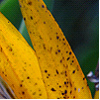 Strelitzia reginae flower
Strelitzia reginae flower
Symptoms
Fungus attacks all the above or below ground level parts of the plant living within the tissue of the plant and are very small and not normally detected until the fruiting body appears. However parasitic types such as powdery mildew or rust are visible on the outer surface of the plant.
Fungi hyphae may be divided by cross walls and known as "septate" while others with no cross walls are known as "nonseptate". These are the fungi responsible for cell leakage as in rot.
Back Mold (Chalariopsis thielavioides) affects understocks of grafted Rosa species by inhibiting the development of callus. It is whitish-grey maturing to black and can be found in the pith of the rose stem.
Black Root Rot (Chalara elegans).This recently introduced fungal disease in Australia (1993) affect plants by blackening the root systems and turning leaves yellow or purple. It is difficult to identify specifically as other pathogenic root diseases and nutritional deficiencies have simular characteristics.
The asexual spores are dispersed by wind or water. It is also transmitted on insects and in contaminated growing media or plants preferring humid moist conditions.
This fungus affects a wide range of ornamental plants including; annuals, perennials and shrubs. Examples are Begonia, Boronia, Camellia, Cyclamen, Fuchsia, Gerbera, Grevillea, Impatiens, Pansy, Petunia, Rosa species and Snapdragon.
Black Stem Rot (Pythium splendens) normally is a rot that occurs in cuttings turning the stem progressively black and shrunken. The leaves fall and the plant becomes stunted, eventually dieing.
Bleeding Necrosis (Botyosphaeria ribis) attacks and kills the inner wood causing the bark to split open and bleed sap giving it an oily appearance.
Blight (Endothia parasitica) is a serious pest of Castanea species, entering the twigs and small branches, and then progressively travelling throughout the tree killing it. It may form cankers on the base of the trunk or in the dead branches above with the amber coloured fruiting bodies pushing there way through the bark.
Copper Web ((Rhizoctonia crocorum). This fungal disease appears in defined patches causing the corms in the centre to become a black powdery mass. Corms on the outer ring of the patch that are partially infected forming a felty mass of violet threads on the corm scales. These threads extend into the soil and large sclerotia forms in the soil and on the corms. Healthy corms become infected from contaminated soil that contains mycelium and sclerotia.
Dry Rot (Phyllosticta concave) forms small circular spots that increase to a diameter of 30mm, and then becomes sunken as the cells collapse. The infected area develops minute black fruiting bodies.
Dutch Elm Disease (Ceratocystis ulmi) is a serious fungal problem of Ulmus species that initially causes yellowing then wilting of the leaves that turn brown and die. This may be seen on certain branches of the tree and on inspection under the bark the sapwood reveals brown streaks. A cross section of the affected branch displays round spots that are dark brown. This infection normally spreads quickly throughout, killing the tree in one to two seasons.
Dieback in Camellia (Glomerella cingulate) is a pathogenic fungus that infecting existing wounds such as leaf scars or mechanical damage, forming a sunken area (canker) that spreads around the stem causing die back. The affected plant has new shoots that are brown-black and the tips curl, forming a 'Shepard's Crook' appearance. The leaves also die but are persistent on the plant and the spores are found in soil or on other infected plants.
Curvularia Leaf Spot (Curvularia species) in Turf Grass. This is normally a secondary weak fungal infection that forms spots on the leaves that lengthens turning the leaves greyish. The leaf shrivels then dies and infected areas appear as weak patches in the turf. Preventive measures include minimising leaf wetness and excessive use of nitrogen fertiliser.
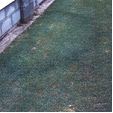 Fairy Rings Blue Couch
Fairy Rings Blue Couch 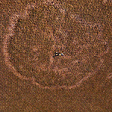
Fairy Rings are a fungal problem in Turf Grass and is caused by several species including (Lycoperdon species), (Marasmius species) and (Tricholoma species). Rings appear in the turf as fruiting bodies or dead grass and as lush green foliage. The mycelia expand radially in the turf feeding on soil nutrients and organic matter with water present.
Under severs conditions the mycelia consume all available nutrients resulting in the death of the turf. Lush turf can result from a less developed infection, where the decomposing hyphal releases nitrogen. This available nitrogen may be beneficial to the turf but some forms of nitrogen are detrimental.
Leaf Blister (Taphrina coerulescens) appears as yellowish circular raised areas on the upper side and depressions on the underside of leaves, up to 15mm across. As the fungus spreads the leaf dies but remains attached to the tree and this infection is commonly found on Quercus species..
Leaf Blotch (Guignardia aesculi) forms small or large water soaked spots that are reddish with a bright yellow margin and form black fruiting bodies in the centre. The affected leaf and petiole have a scorched appearance before falling, found on Aesculus species
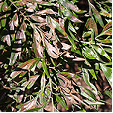 Grevillea robusta
Grevillea robusta 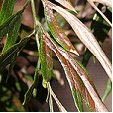 Leaf Scorch
Leaf Scorch
Leaf Scorch (Verrucispora proteacearum) is a fungal disease that infects leaves causing large parts of the leaf to turn grey-brown, giving the appearance that it has been singed by fire. Black fruiting bodies appear on the affected areas and the leaf soon withers then dies. New, mature leaves are affected during very wet periods towards the end of the branches and Grevillea and Hakea species are susceptible.
Melting Out (Helminthosporium vegans) forms bluish black spots with straw coloured centres on the leaves and may be found on the sheath, encircling it causing Foot Rot. It infects grasses particularly Poa pratensis. There is another fungus that is simular Helminthosporium Blight (Helminthosporium dictyoides) that infects Poa, Festuca and Agrostis species.
Pad decay (Aspergilus alliaceus) infects Cereus and Opuntia species and occurs at during periods of high temperature. The yellow spores at the epidermal layer through wounds and germinate on mass causing the area to become soft and spongy. An anthracnose called Shot Hole is a similar forming brownish spots the turn grey, and then black destroying pads. Control methods include physically removing damaged pads and allowing the Sun to heal wounds.
Potato Gangrene (Phoma foveate) is a soil borne fungus that infects the roots during harvest primarly through wounds and develops during storage. The potatoes rot from the inside forming rounded depressions on the surface and have a strong odour of rotten fish.
Root Rot Fungi (Phymatotrichum omnivorum) and (Pellicularia filamentosa) cause the roots to rot and the plant suddenly wilts then dies.
Root Rot (Pythium debaryanum) forms water soaked dark brown streaks that affect all parts of the plant causing wilting then dieing. It infects Ranunculus species, it also infects cactus species by forming brown spotting and wilting that appears at the base of the plant then extends towards the top. It quickly spreads from plant to plant in collections and is controlled by avoiding over watering, excessive humidity and are using a sterilised soil when potting up.
This fungus also is responsible for damping off of seedlings in a glasshouse environment.
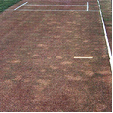 Spring Dead Spot
Spring Dead Spot 
Spring Dead Spot (Leptosphaeri species) is a fungal disease that infects Couch Grass. It first appears during autumn as pale bleaches areas up to 500mm (20in) wide and persists throughout winter. In spring the affected areas do not recover or recover slowly and on inspection the roots or rhizomes are rotted. Runners from the surrounding healthy turf will help with recovery and all signs of the problem disappear by mid summer.
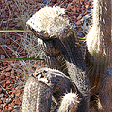 Cactus species
Cactus species 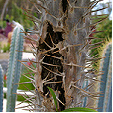 Pachypodium species
Pachypodium species
Stem Rot (Helminthosporium cactivorum) forms well defined yellow lesions that mature into soft dark brown rot. It commonly infects Cactus species entering through the stomates or wounds. Heavily infected plants collapse and die.
Stem Rot or Basal Rot (Pellicularia rolfsii) is a soil borne fungus that infects the stem root junction and extends into the leaves. In orchids the leaves become discoloured, dry and detach from the base which is covered in a fungal growth that produces sclerotia. The sclerotia is whitish to yellow then becoming dark brown and can be viable for up to four years.
White Mold (Ramularia desta f. odorati) occurs on both sides of the leaf and looks simular to powdery mildew but forms faint dull, reddish brown elongated spots on the leaf that may be depressed or along the margin where they have a watery appearance. Tufts of hyphae develop in the stomates.
Wilt (Ceratocystis fagacearum) causes leaves to curl then turn brown and the sap wood may also turn brown or black. Heavy infection may kill a tree within two seasons and is found on Quercus species and other ornamental trees.
Witches Broom may be a fungal problem that causes a proliferation of small axillary shoots to appear at the end of the branches. Little is known about this problem, though it affects a wide range of plants including Eucalyptus, Leptospermum and Pinus species.
Source and Dispersal
Fungus is found in the soil or on other infected plants and after releasing the spores, they are dispersed by wind or are transmitted in infected stock, insects and with splashing water.
Wilt is transmitted by infected root stocks, several species of insect and contaminated tools.
Dutch Elm Disease is transmitted by bark beetles such as (Scolytus multistriatus) and (Hylurgopinus rufipes). These beetles deposit eggs in the sapwood where the lava tunnel and pupate. The emerging beetles tunnel the bark and carry the fungus to fresh feeding sites on the tree. Infected beetles may also be transported to fresh sites in waist material.
Favoured Conditions
Prefers cool moist conditions with temperatures from 10º to 25ºC and is more common from autumn to spring when it is wet.
Affected Plants
A wide range of plants and all parts can be infected by various fungal diseases. Bleeding Necrosis is found in Liquidambar species and Stem Rot or Dry Rot infects Cactus species such as Opuntia and Pelargonium.
Abies species are infected by several fungi that cause Leaf Cast which turn the needles yellow to brown then fall prematurely.
Abutilon species are infected by the Stem Rot (Macrophomina phaseolin) affecting the lower stems and is not commonly seen.
Achillea, Cuphea, Leucanthemum, Euphorbia species are infected by the Stem Rot (Pellicularia filamentosa) which enters through the roots and rots the base of the stem.
Alternanthera species are infected by the Leaf Blight (Phyllosticta amaranthi) which forms small brown spots on the leaves causing them to curl and die.
Aloe, Astrophytum, Copiapoa, Echinocactus, Espostoa, Ferocactus, Gymnocalycium, Kalanchoe and Schlumbergerera species are infected by Bipolaris Stem Rot (Bipolaris cactivora). This infection affects many cacti species causing rot in the stems with a blackish appearance.
Amelanchler is affected by the Witches Broom (Apiosporina collinsii).
Antirrhinum species are infected by the Blight (Phyllosticta antirrhini) that forms light brown spots on the upper-side of the leaf and on the stem. As the spots enlarge they turn greyish with black fruiting bodies in the centre, then become brown and killing the affected areas.
Begonia species are infected by the Stem Rot (Pythium ultimum) turning stems black then becoming soft and causing the plant to collapse. This is the same fungus that causes Damping-off.
Betula species are affected by the Leaf Blister (Taphrina bacteriosperma) which curls the leaves and forms reddish blisters.
Chamaedorea and other cain-like species are infected with Gliocladium Stem Rot (Gliocladium vermoseni) which forms a dark basil stem rot generally on damaged plants and produces orange-pink spores. The mature leaves are first affected and eventually the stems or cains rot and die.
Crocus and Gladiolus species are infected by the Dry Rot (Stromatinia gladioli), which causes lesions on the corms and rots the leaf sheath.
Crocus, Iris, Tulipa, and Narcissus species are infected Copper Web ((Rhizoctonia crocorum).
Dianthus species are infected by Phialophora Wilt (Phialophora cinerescens) that causes the leaves to fade and plants to wilt. There is obvious vascular discoloration which is very dark. It is not found in Australia.
Erythrina x sykesii may be infected by the Root Rot Fungi (Phymatotrichum omnivorum).
Fern species are infected by Tip Blight (Phyllosticta pteridis). This blight produces ash-grey spots with purple brown margins and the fruiting bodies appear as black pimple like spots. It is transmitted by air or moisture and in infected fronds become brown and die. Control methods include sprang fungicide on leaves or reducing humidity and avoid wetting the fronds.
Forsythia species are infected by Stem Gall (Phomopsis species). It forms rounded growths along the stems causing them to die and look unsightly.
Gladiolus species are infected by Penicillium Rot of Corms (Penicillium gladioli). This disease forms deeply sunken reddish brown areas that become corky and produce a greenish fungal growth.
Hedera species are susceptible to several Fungal Leaf Spots including (Glomerella cingulate), (Phyllosticta concentrica) and (Ramularia hedericola). All of which cause yellowish spots that develop into dry brown blotches that kill the leaf.
Larix species are susceptible to Leaf Cast (Hypodermella laricis). This fungus attacks the needles and spur shoots turning them yellow at first then brown after which small black fruiting bodies appear on the leaves during winter.
There are several other fungi including (Cladosporium species) and (Lophodermium laricis) cause leaf blight or leaf casts.
Orchids such as Cattleya, Cymbidium, Cypripedium, Dendrobium, Epidendrum, Oncidium, Paphiopedilum, Phalaenopsis and Zygopetalum species are infected by Phomopsis Rot (Phomopsis species). This fungal problem forms a firm brown rot that appears on the leaves, pseudobulbs and rhizomes. The affected areas have yellow margins and the centre is covered in tiny black specks (fruiting bodies). Cattleya species are particularly susceptible. These plants are also infected by Psudobulb Rot (Mycolleptodiscus coloratus implicated). Dark spots appear on the pseudobulbs eventually causing extensive rot and killing the bulb.
Palms are infected by the fungus Butt Rot (Ganoderma sulcatum). The fungus entered the lower trunk normally as a result of mechanical damage (lawn mower). Symptoms include stunting of new growth and yellowing of the lower leaves. Fruiting bodies become evident at the base of the trunk. There is no effective control method and replanting in infected soil should be avoided.
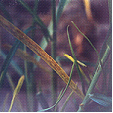 Kikuyu Yellows
Kikuyu Yellows 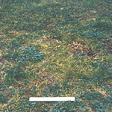
Pennisetum clandestinum (Kikuyu) is susceptible to Kikuyu Yellows (Verrucalvus flavofaciens), thisis a water mould that infects the roots and causes them to rot. The infection extends up the stem and onto the leaves with yellow discolouration and can be limited to a small or large area up to 1m (3ft) wide.
It is found in warm temperate to sub tropical regions and dispersed in infected soil or plant material. There is no chemical control, nitrogen fertiliser masks the symptoms and complete fertiliser encourages stronger roots to fight the disease.
Pittosporum, Antirrhinum, Aquilegia, Echinops and Orchid species are infected by the Stem Rot or Basal Rot (Pellicularia rolfsii) commonly in the northern hemisphere and preferring humid glasshouse conditions.
Solidago species are infected by the fungal Scab (Elsinoe solidaginis) which covers the leaves and stunts the growth of the plant. Young plants may be killed.
Trillium species are infected by the stem rot (Pellicularia rolfsii) and ( Ciborinia trillii). This normally occurs in wet soils and is detrimental to the plants life.
Tsuga species are infected by Sapwood Rot or Butt Rot (Ganoderma lucidum) and (Coniophora puteana), which attacks the sapwood close to the bark, towards the base of the tree. Commonly killing the host.
Tulipa species are affected Blue Mold (Penicillium species) and the fungus (Rhizopus stolonifer) causing rot in the bulbs.
Vinca species are infected by the soil born Root Rot (Pellicularia filamentosa) which rots the stems and roots.
Viola species may be infected with the Scab (Sphaceloma violae) which attacks all parts of the plant including the seed capsule forming yellowish spots that turn brown and in leaves fall out. Stems and petioles can be girdled killing the upper part.
Viola species are also infected with the Stem Rot (Myrothecium roridum) which attacks the stems at ground level causing them to become dry and brittle. The leaves show symptoms by turning purplish-black and this fungus also infects Alcea and Antirrhinum species.
Non-chemical Control
Generally remove and destroy any infected plants or plant parts, when replanting, avoid using susceptible species for 3 years. When growing crops space the plants to reduce the humidity and airflow and cultivate the soil to increase the drainage. Remove weed growth from around the susceptible plants.
Avoid over watering the surrounding soil which encourages fungal development. In the case of trees remove any infected branches and heavily infected trees should be cut down and removed. This infected material should be disposed or burnt. Damaged trees should have the wounds dressed and sealed as a preventative measure particularly for Dieback in Camellia.
Deter Potato Gangrene by planting clean stock and be careful not to damage the crop when weeding. When harvesting the tubers choose a dryer period and be careful not to damage them.

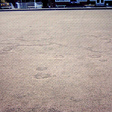 Fairy Rings
Fairy Rings
Fairy Rings in Turf are difficult to control and may appear or disappear sporadically. Cultural practice such as minimal thatch build-up, regular aeration and a reduction of organic matter spread on the turf will reduce infection.
Chemical Control
No suitable fungicides available, though drenching or spraying the soil with the fungicide dichloran helps control soil born fungi.
Note
Always read the label for registration details and direction of use prior to application of any chemicals.
DISEASE
NAME
Oedema
Environmental (Water)
Description
This is an environmental problem where the leaf or stem has a build up of water causing swelling of the epidermal layer.
Symptoms
The leaf develops small brown corky areas that have a scabby appearance. It commonly occurs in damaged areas of the leaf ie: torn or broken leaf parts and where insects have attacked.
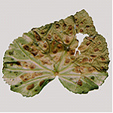 Begonia species
Begonia species 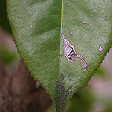 Camellia species
Camellia species
Image by B. Sonsie
Source and Dispersal
This is an environmental problem and as such has no direct source.
Favoured Conditions
It prefers a high humidity low light environment and is triggered by over watering as in a humid glasshouse or when plants are grouped together with poor air circulation.
Affected Plants
Begonia species are affected by forming a Corky Scab on leaf undersides and down the stems as a direct result of Oedema.
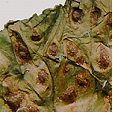 Corky Scab
Corky Scab
Cactus species are infected by Corky Scab, which is seen as rusty or corky spots along the stems with the epidermal layer becoming dry then breaking open and curling. The spots as soon form a thick covering with only the new growth free. Under extreme conditions it will kill plant and mild infections reduce flower production. Control methods include increasing the light, decrease in humidity and improving air circulation. A similar appearance on cactus may result from overexposure to direct hot sun. It appears as sunken brown or white patches developing on one side of the stem where the chlorophyll has been destroyed (cooked).
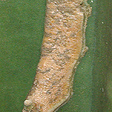 Corky Scab on Cactus
Corky Scab on Cactus
Camellia species are particularly susceptible but it also affects Gardenia, Acalypha and Schefflera species.
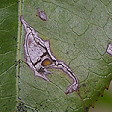 Camellia species
Camellia species
Non-chemical Control
Remove and destroy affected leaves and regulate watering of the plant by not over watering or watering at night.
Chemical Control
There is no effective chemical control.
Average Lowest Temperature : 0º C 32º F
USDA : 9, 10, 11
This USDA (United States Department of Agriculture) hardiness zone chart can be used to indicate a plant’s ability to withstand average minimum temperatures. However, other factors such as soil type, pH, and moisture, drainage, humidity and exposure to sun and wind will also have a direct effect on your plant’s survival. Use this chart only as a guide, always keep the other factors in mind when deciding where, when and what to plant.
A plant's individual USDA zone can be found in the Plant Overview.
Climate Description
Desert
This zone has low humidity with high summer temperatures and cold winters.
Frosts and droughts are severe with strong very dry wind.
Plant growth
Endemic native and few exotic plants survive.
| Dictionary | Growth Habit |
| Leaf Type | Botanic Flower Description |
| Leaf Shape | Flower Inflorescence |
| Leaf Arrangement | Fruit Type |
| Leaf Margin | Bark Type |
| Leaf Apex And Bases | Flower Description |